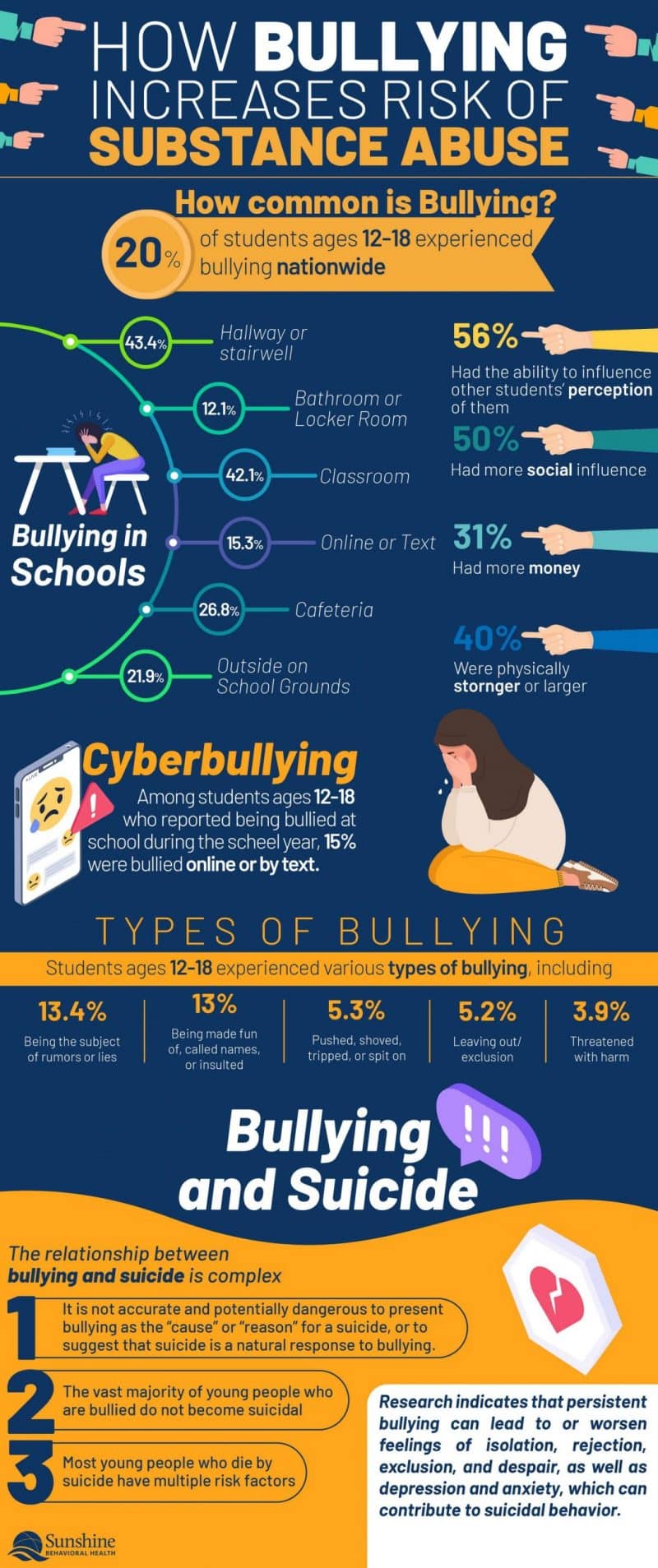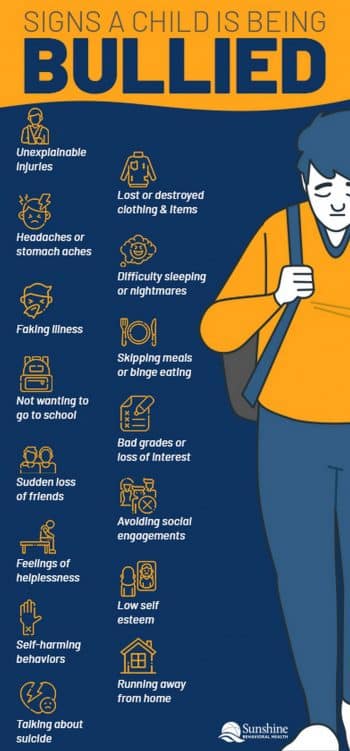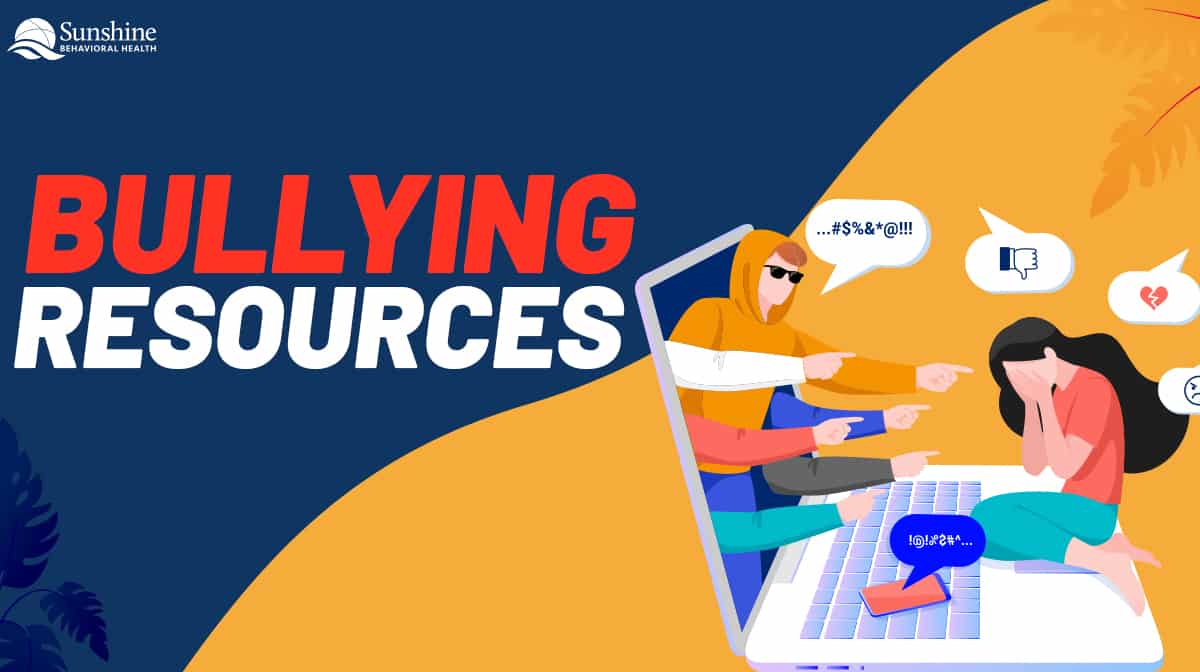Sticks and stones may break my bones
But words will never hurt me.
That old English children’s rhyme is right, up to a point, but the truth is bullying — which can be done with fists or words — hurts.
If you haven’t been bullied, you’ve more than likely been witness to it, even if it’s only by seeing it on television and in movies. Regina George from Mean Girls and Nelson Muntz from The Simpsons are two well-known pop culture bullies. Carrie White (from Carrie , of course) is a well-known victim. Many celebrities, even Lady Gaga , have admitted to being bullied.
Bullying is far from rare. According to the National Center for Education Statistics, one of every five U.S. students ages 12-18 has been bullied. Bullying has been proven to lead to low self-esteem, anxiety disorders, depression, and even addiction.
What Is Bullying?
Simply put, bullying is when a person or a group repeatedly hurts, belittles, or scares someone on purpose. It can be physical, social, or verbal. It can — and often does — occur online in the form of cyberbullying. (More often, cyberbullying is anonymous, but it can be more relentless and persistent.)
It can happen at any age — and at home, or school, or at work. It’s aggressive in nature and typically is repeat behavior. There’s an imbalance of power in that the victim is seen as weaker.
Even if bullying happens only a few times, it can affect physical and emotional health, both immediately and for years after the fact. It can lead to injury, social problems, emotional turmoil, and even death .
Not only does it harm the victim, but it also hurts bystanders as well as the bully . (Bullies are more prone to substance use disorder and academic problems and to becoming the victims of violence.)

Types of Bullying
It’s not limited to the playground or lunchroom, though. It also happens in the workplace. The three main types of bullying are:
- Verbal. This includes taunting, threatening, and name-calling.
- Social. Also known as relational bullying. Usually the goal is to damage someone’s reputation or relationships. It includes spreading rumors, embarrassing someone in public, or excluding someone.
- Physical. This involves hurting a person — hitting, kicking, tripping, shoving, or spitting — or stealing or breaking someone’s things.
One last type of intimidation is cyberbullying, where the tormentor uses technology to hurt or embarrass another. It can take on a number of forms , including:
- Sharing embarrassing or unpermitted pictures or videos.
- Doxing, or sharing someone’s private information online.
- Threatening someone.
- Pretending to be someone else by creating false accounts, or posing as someone else to get them to reveal personal details.
More than a third of adolescents (37%) between the ages of 12 and 17 have been bullied online . Girls are more likely to be the target or as well as perpetrators of cyberbullying. Fifteen percent of teen girls have been cyberbullied. Half of LGBTQ+ students have been harassed online.
Cyberbullying has unique challenges. It’s more often anonymous, and because the tormentor can send messages any time, it’s more persistent. Being the victim also makes one more vulnerable to self-harm or suicidal behaviors.
Trolling — when someone deliberately posts comments with the intent to anger or upset others — is sometimes mentioned in discussions of cyberbullying. Trolling is more about getting attention and being annoying, whereas cyberbullying is more targeting, and the bully can be motivated by anything from revenge to popularity; or to offend, humiliate, or intimidate.
It’s best to ignore trolls. Without attention and outrage, they tend to peter out.
Cyberbullying is trickier to handle. Laws on battling it vary from state to state.
Parents can better prevent it by keeping track of their children’s online activities, teaching what is appropriate and inappropriate, and devising strategies for dealing with a bully or a predator.
What are the Effects of Bullying?
Children and teens are affected by bullying in many ways. About 160,000 teens skip school each year because of it.
Bullying can harm the victim, the bully, and bystanders.
Targets of bullies tend to score lower in reading, mathematics, and science compared to non-bullied peers. They may feel anger, hurt, or fear as a result.
One study found that bullying behaviors — even for bystanders — put youth at higher risk for substance use disorder. The bullied and the bully , however, are more likely to partake than witnesses. Victims are at greater risk for:
- Depression, anxiety, low self-esteem. This can extend into adulthood.
- Health complaints such as stomach aches or headaches, or experiencing sleep problems.
- Lower grades and test scores.
- Missing school, or even dropping out of school.
- Suicide.
Early bullying may set the stage for later substance use disorder. One study followed youth through a number of years. Youths who were victimized in fifth grade had a greater likelihood of substance use by tenth grade.
Bullies themselves are also at higher risk for substance use disorder, school problems, and violence later in life. In cases of children and teens who are both victims of bullies and bullies themselves, they are more prone to develop behavioral and mental health problems compared to bullies and people who are bullied.
Anyone with any connection to bullying — as an instigator, victim, or witness — is at higher risk for depression. Bystanders also may resort to escaping via substance use disorder.
Drug and alcohol use are especially problematic for adolescents and young adults.
Substance use puts them at risk for dangerous behaviors, such as driving under the influence and sexual assault. Over the long term, it can impact brain development (which continues into one’s twenties) and fast-track some people to numerous diseases of the lung or heart as well as strokes, cancers, and mental health problems.
 Who Gets Bullied?
Who Gets Bullied?
Anyone can be the victim of bullying. Boys tend to be bullied physically while girls are harassed psychologically. A person is at greater risk, however, if they are:
- Are seen as different somehow, such as being overweight or underweight, poor, a different race or ethnicity, or LGBTQ+.
- Are viewed as weak or vulnerable.
- Have depression, anxiety, or low self-esteem.
- Have no or few friends or are less popular.
- Have more difficulty socializing compared to others.
- Have some kind of intellectual or developmental disability.
Who Bullies?
Certain factors make one more likely to bully others . Children and teens who have some social clout, who worry about their popularity, or like to be in charge of others, they may target those they view as less-than.
The following can fuel bullying behaviors, too, including:
- Aggression or frustration.
- Depression or anxiety, low self-esteem.
- Feeling isolated from peers.
- Troubled home environment (abuse, neglect).
- Struggles with following rules.
- Viewing violence as a positive thing.
- Peer pressure.
- Having friends who bully others.
Signs of Bullying
Many children and teens who are bullied never report it . They fear the bully will double down on the abuse, or they believe that no one cares or can do anything. But there are signs that may mean a child or teen is a victim of intimidation. They include:
- A shift in behavior, such as becoming more withdrawn or expressing a dislike of school.
- A drop in self-esteem.
- Ailments such as stomach pain or headaches, or faking illness.
- Changes in eating or sleeping habits.
- Lower grades.
- Self-destructive behaviors such as running away, self-harm, or substance use disorder.
- Unexplained injuries.
- Lost or destroyed property.
If a child or teen is a bully or is suspected of bullying, they may show signs of aggression, face frequent discipline at school, or be excessively competitive or anxious about their performance or reputation.
What to Do If You See Bullying?
Not all youths feel comfortable opening up about bullying. It’s difficult to put a rapid stop to the behavior, but listening, being aware of the problem, and actively working toward developing an anti-bullying culture can help.
When you know a child or teen is being bullied, it’s important to show support:
- Listen to them and assure them you want to help.
- Let them know that the bullying is not their fault.
- Understand that it’s painful for kids to open up about bullying. A school counselor, psychologist, or other mental health professional may be a more neutral sounding board.
- Discuss what can be done. Try role-playing. Address how to react to the bullying.
- Work to remedy the situation. Talk to the school, for example. Get people involved.
- Follow up. Bullying usually doesn’t end right away. It may take time. Let the child know you’re backing them every step of the way.
- The bully should be informed that the behavior is wrong, harmful, and sometimes illegal.
- Let everyone know the bullying will not be tolerated.
Victims should feel comfortable enough to speak to someone they trust. Ideally, there will be a plan in place or a plan being developed to nip bullying in the bud.
Anti-Bullying Programs
There are many programs and plans being implemented nationwide — globally, even — to put bullying behaviors into the past.
What doesn’t work is a band-aid approach. A school holding an assembly to say “Bullying is bad. Don’t do it” rarely gets results. The causes of and motivations for bullying are simply too complex to be resolved in an hour or two.
The same goes for having the bully and the victim meet to discuss the issue and promise to make peace. More than anything, that usually leads to more bullying.
There are a number of programs that seek to change the culture. Call it a form of positive peer pressure.
Instead of zero tolerance for last year’s practices, several initiatives strive to develop strategies that weave anti-bullying principles and practices into the fabric, rather than the fringes, of the curriculum. Some promising programs and resources include:
- Cyberbullying Research Center. This site has information on cyberbullying and offers tools to put a stop to it. It’s geared to educators, parents, and youth alike.
- KiVa: This program originated in Finland and focuses primarily on tween-age students. It aims to make bystanders aware of their role in encouraging (intentionally or unintentionally) bullying; raise empathy and support for victims; and teach coping skills via lessons and simulation games. It’s an approach that involves students, school personnel, and parents. So many bullying victims reported that they had better self-esteem and less depression that Finland adopted the program nationwide.
- Olweus Bullying Prevention Program. This program began in Norway . It’s still relatively new but early results seem promising. Schools are encouraged to make anti-bullying classes a part of the curriculum, including ways to deal with victims and bullies. Bystanders’ roles are also considered, as well as what sparks bullying. Social and emotional intelligence are also taught.
- School Climate Improvement Resource Package . This site has resources to help schools develop a more compassionate and accepting culture.
- Sources of Strength. This program focuses on preventing suicide , bullying, and substance use disorder by encouraging peers to seek help when needed, and by promoting peer and adult adviser connections. Identifying and cultivating sources of strength — there are eight sources that include family, friends, mental health, and mentors — are encouraged since they’re considered key in preventing suicide. If a student struggles to find the support of friends but has family looking out for them, a mentor, and healthy activities, those factors can be extremely uplifting.
- StopBullying.gov. This is a clearinghouse of federal information on bullying, led by the U.S. Department of Health and Human Services and the U.S. Department of Education. It includes resources that can help families, educators, and members of the community as well as links to state laws.
Workplace Bullying
Once a person leaves school, most people think that’s the end of bullying, but it can happen to anyone at any time, including the workplace. If bullying is meant to single someone out, humiliate, or intimidate someone, that’s considered abusive. Examples of on-the-job bullying include:
- Threats, mocking, humiliation, jokes, or gossip.
- Being given wrong information, such as incorrect deadlines or insufficient directions, or stealing credit for work or ideas.
- Taking one’s personal or workplace items.
- Excess job monitoring, spying, invading privacy, or social exclusion.
- Harsh criticism or placing wrongful blame.
Not all criticism is bad, though. If it’s constructive and can help a person better perform their work duties, that’s not considered bullying. Neither is any disciplinary action linked to poor job performance or inappropriate workplace behaviors.
If seemingly random occurrences — such as being publicly criticized, heavily monitored, assigned duties not part of one’s job description or that one was never trained for (despite requests) — those point to workplace bullying.
Workplace bullying tends to occur in places that are stressful, have heavy workloads, poor communication, or unclear policies.
There are a lot of negative consequences too. Bullying can lead to headaches, high blood pressure, or digestive ailments. People may find it difficult to sleep at night or struggle to get up in the morning to face the day. They may feel anxious, depressed, or worthless.
If bullying escalates, it can hurt morale and slash productivity. Workers may quit frequently. There may be more absences. Loyalty is reduced.
If there is bullying, it’s best to document it. Save the evidence. Report it to human resources or a trusted supervisor. Know your workplace policies. If you have a trusted coworker or supervisor, seek help or input from them.
If necessary, legal guidance may help. Therapy can too. Letting the problem fester or dulling the ache with substance use disorder, however, is a solution that does little good for anyone.
Sources
Medical disclaimer:
Sunshine Behavioral Health strives to help people who are facing substance abuse, addiction, mental health disorders, or a combination of these conditions. It does this by providing compassionate care and evidence-based content that addresses health, treatment, and recovery.
Licensed medical professionals review material we publish on our site. The material is not a substitute for qualified medical diagnoses, treatment, or advice. It should not be used to replace the suggestions of your personal physician or other health care professionals.







